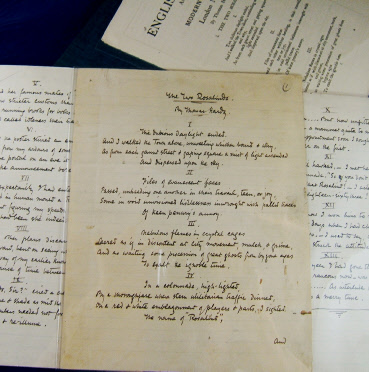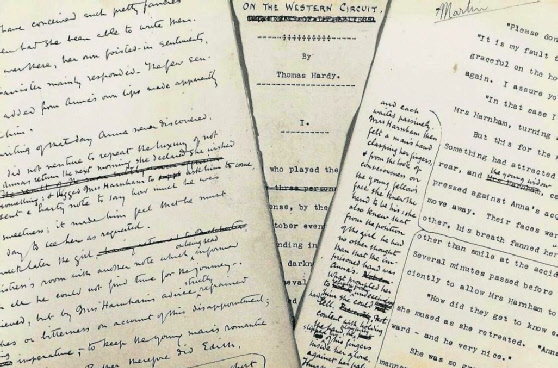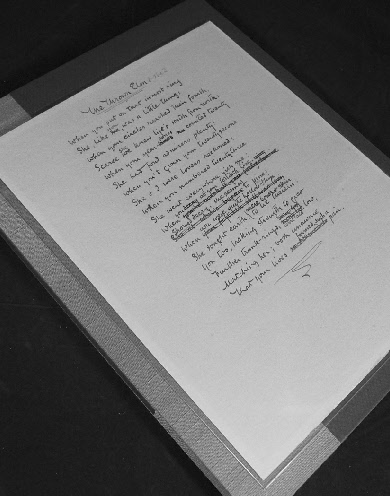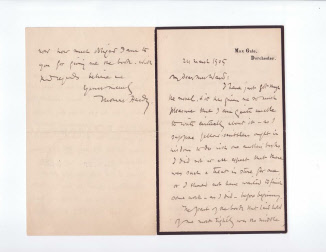


Collecting Thomas Hardy

Novelist and Poet 1840-1928

Manuscripts
Hardy, Thomas. ON THE WESTERN CIRCUIT. Complete original 43-page typescript with Hardy's extensive holograph revisions of this important Wessex short story which was first published in The English Illustrated Magazine (December, 1891), and later collected in Life’s Little Ironies (1894). First page slightly worn and soiled, else Very Good, the typescript consists of 43pp, 4to, one page trimmed to half size, with numerous holograph revisions throughout, many extending to several lines, and one whole page (numbered 27-28) entirely in Hardy's hand. In total, 38 of the 43 pages of this unexpected survival bear Hardy's deletions and insertions, representing an extensive re-working of the short story. While a manuscript version of “On The Western Circuit” was given by Hardy to the Manchester Central Public Library in 1911 under a different title, printer’s marks here indicate this to be the copy used to set the type for its initial periodical appearance.
“On The Western Circuit” was composed between the completion of TESS OF THE D’URBERVILLES and the beginning of JUDE THE OBSCURE when Hardy was at the height of his fiction writing prowess. Its tragic story of a doomed courtship-by-letters is set in contemporary urban Melchester (Salisbury) and entangles a London lawyer, traveling ‘on the western circuit' of town-to-town judiciary matters, with two Wessex women (one bored and married, the other beautiful and illiterate), pursuing its dark and ironic anti-marriage theme both with an admirable economy of plot and an uncharacteristic sharp stab of realism.
Thomas Hardy’s brilliant short fiction has long been hidden in the shadow cast by both his novels and poetry. But “On The Western Circuit” can fairly make the claim to be the best known of Hardy's forty-nine short stories. Under the name "Day After The Fair," it was successfully adapted for the London stage by Harold Pinter with Deborah Kerr in the starring role (1972), later developed into a two-hour BBC film which aired on PBS’ Masterpiece Theatre (1988), and most recently it was strikingly produced as a musical on the New York stage (1999).
As Hardy gave away virtually all of his manuscripts while he was still alive, the survival of this revised typescript is no doubt due to the special requirements of its serial publication. The periodical editors of The English Illustrated Magazine characteristically imposed on Hardy certain restraints so he would not, as usual, offend the perceived Victorian taste of the time. Although Mrs. Harnham is here made a widow and there is no mention of Anna's pregnancy (as is found in the final version in Life’s Little Ironies), Hardy uses this revised typescript to do a more substantial exploration of his material. Almost all of the heaviest revision involves new phrases and changes which subtly increase the frankness of the characters' sexuality in counterpoint to his editorial instructions. Most important of all, here he adds in a long handwritten marginal paragraph, the key incident...Raye's accidental and erotic touch of Mrs. Harnham's hand at the crowded fair... which triggers the whole tragic consequence of the story. Provenance: Ex- A.P. Watt, Thomas Hardy's literary agent, who handled the publication of On The Western Circuit both in England (English Illustrated Magazine, December 1891) and in America (Harper's Weekly 28 November 1891). This typescript was sold at Sotheby’s London in December, 1988 (lot 47, GBP 28, 600). In the Collected Letters, Hardy writes Watt thanking him for his services in regard to this story's publication (January, 1892). See Purdy pp.81-86. Housed in a full green morocco folding box.
Hardy, Thomas. AUTOGRAPH MANUSCRIPT, SIGNED of his poem, "THE TWO ROSALINDS", 3pp. 4to, n.p., n.d. [1909]. Hardy's fair copy submitted to the publisher, consisting of twelve quatrains written on the rectos of 3 sheets of ruled paper, with some small stains and fingerprints suggesting its use as printer's copy for the first English printing; a small marginal tear at foot of each page repaired with adhesive tape, a little edge-worn, otherwise in very good condition. "The Two Rosalinds" was Hardy's nostalgic poem about an actress who played the part of Rosalind (in Shakespeare’s "As You Like It") forty years earlier. It was first printed in "Collier's" (New York), 20 March 1909, p. 24, and then in "The English Review", April 1909, pp. 1-3. This is the manuscript prepared for the latter. Together with original pages 1-6 detached from "The English Review" of April 1909 containing the full text of Hardy's "London Nights", comprising "The Two Rosalinds" and "Reminiscences of a Dancing Man" along with the original front cover of the magazine. First book publication took place in Hardy’s 94-poem collection Times Laughingstocks (1909) where “The Two Rosalinds” appeared as third poem in the order. In a half morocco slipcase. From the collection of Frederick B. Adams, Jr., with his bookplate.
HARDY, THOMAS. “THE THROWN ELM & SHE” Unsigned, original holograph manuscript, one page, 4to, (n.p., n.d.) Eighteen lines of verse, written in ink, on fine paper, titled at the top, "The Thrown Elm & she?" (“& she” being in pencil) beginning: "When you put on that inmost ring / She, like you, was a little thing: / When your circles reached their fourth, / Scarce she knew life's south from north. . . ." Lightly and uniformly faded and toned (from a previous framing), but essentially in Near Fine condition. Housed in a new green folding case. According to Purdy (p. 255) this is the manuscript "given by Hardy himself to Mrs. St. John Hornby.” C. H. St. John Hornby (1867-1946) was the founder of the famous ASHENDENE Press in 1895 and served as chair of the Hardy memorial committee after the author’s death. It is an earlier draft with alterations and alternative readings." The final version was first published in WINTER WORDS (1928) under the title, "The Felled Elm and She."
THOMAS HARDY’S ORIGINAL CORRECTED TYPESCRIPT OF HIS SHORT STORY: “ON THE WESTERN CIRCUIT” (1891) WITH EXTENSIVE REVISIONS
Rare Thomas Hardy working manuscript
Hardy, Thomas. AUTOGRAPH LETTER SIGNED, 4pp, 8vo, on headed stationery of Max Gate, Dorchester, 24 March 1905. Superb literary letter to fellow author Mrs. Humphry Ward (1851-1920), analyzing and praising her recent novel The Marriage of William Ashe (1905). Hardy extensively discusses Ward’s characters, her writing style, and his personal feelings toward her book: “…the novel…has given me so much pleasure that I am quite unable to write critically about it – as I suppose fellow scribblers ought in wisdom to do with one another’s books…The part of the book that laid hold of me most tightly was the middle third…the culmination & catastrophe…You have exhibited unexpected dramatic powers. Part Two: Ch XII might be almost bodily transferred to the stage…Kitty has, I think, more of my sympathy than you wished her to have…I know somebody like her & so do you…” In Near Fine condition. From the Frederick B. Adams sale, Sotheby’s London 7 November 2001 (lot 524). Printed in the Collected Letters, III, p. 163.
Hardy, Thomas. AUTOGRAPH LETTER SIGNED, 2pp, [September 2nd, no year but 1880, Trinity Road, Upper Tooting S.W). Single sheet, folded once, written on two sides, traces of mount on blank verso. To fellow novelist and editor George Manville Fenn (1831-1909). Here Hardy gives Fenn permission to publish extracts from Hardy's writing. But the bulk of this quite personal early letter from the forty-year old author is unusually self-revealing and not a little touching. In part: "...I question whether any one of [the proposed extracts from his own writing] will affect your readers as I was affected by a fugitive piece of yours in the Graphic a short time ago - on nightingales. I read it in the train on my way to the Continent - & thought as I read how much I should like to know the writer, till at the end I came to your name. I am so glad of this opportunity of expressing to you my sense of the intense pathos of that apparently simple article. The subject lingered with me all day..." Like Hardy, Fenn was self-educated, offered critical social commentary on Victorian England, and shared the assiduous nature required to rise in the literary world from lowly beginnings. Charles Dickens was the editor who first "discovered" Fenn's fiction and published his first sketch in ALL THE YEAR ROUND. Printed in the Collected Letters, volume I, p. 79.
“The Two Rosalinds” [1909]
Autograph Manuscript, signed. Printer’s copy.
Superb 1905 literary letter to Mrs. Humphry Ward about one of her novels
EARLY HARDY LETTER (1880) TO FELLOW NOVELIST GEORGE MANVILLE FENN WITH UNUSUALLY SENTIMENTAL CONTENT
STUNNINGLY CANDID LETTER (1915) TO FELLOW POET ARTHUR SYMONS IN WHICH HARDY URGES HIS FRIEND TO FOREGO PUBLISHING A CONTROVERSIAL NOVEL
Hardy, Thomas. IMPORTANT THREE-PAGE AUTOGRAPH LETTER, SIGNED (“Sincerely Yours, Tomas Hardy”), (Max Gate, Dorchester, May 31: 1915). Single sheet of ordinary watermarked paper. Folded twice, written on 3 sides in black ink. In Very Good condition, traces of having been mounted at some point, sharply inked. To poet, critic, founder of The Savoy, Rhymers Club member, and contributor to The Yellow Book, Arthur Symons (1865-1945). It reads, it part: "My Dear Symons: I have read with much interest the papers you sent & return them herewith lest you should not have kept a fair copy. I don’t call the composition quite a story: it seems rather a study of a certain class of womankind, & mind. As you ask me for advice I daresay you mean advice in a practical sense as to the advisability of printing the MS. without reference to the goodness or otherwise of the work. Also that you wish me to speak quite frankly, whether or no my view accords with your own wishes. Candidly then, I should not, if I were you, publish the study. The present time is particularly unsympathetic with such phases of life & your reputation might not be advanced by printing this. The colossal war in which Europe is engaged must be very suggestive of many things to you & I should not be surprised to hear that the lively imagination which prompted these pages you send has exercised itself in raising some night-mare-ish vision of the terrible events that are happening...” Hardy’s relationship with gifted fellow poet Symons had been an enthusiastic one for over a decade and in Symons Hardy found a kindred spirit with whom he could entrust feelings he otherwise rarely shared. However Symons’ mental health suffered an irreparable blow in 1908 when, in Venice, he suffered a psychotic break which in effect destroyed his creativity forever; he never again published the kind of superior work which won him accolades in his youth. This particular letter refers to Symons’ unpublished novel about a prostitute [THE LIFE OF LUCY NEWCOME]. The subtext of this letter subtly reflects Hardy’s sensitivity toward Symons’ condition; he is aware of Symons’ emotional fragility and his references to the horrific nightmare of World War One on Symons’ “lively imagination” appears (to us, at least) to be Hardy’s way of expressing his deeper understanding for the failure of the novel and a subtle warning that, by publishing this fiction, Symons would further expose himself to hurtful judgment of his deteriorating creative skills. Hardy wrote many exceedingly interesting letters to fellow writers. This is one of the finest we’ve had the good fortune to handle.



